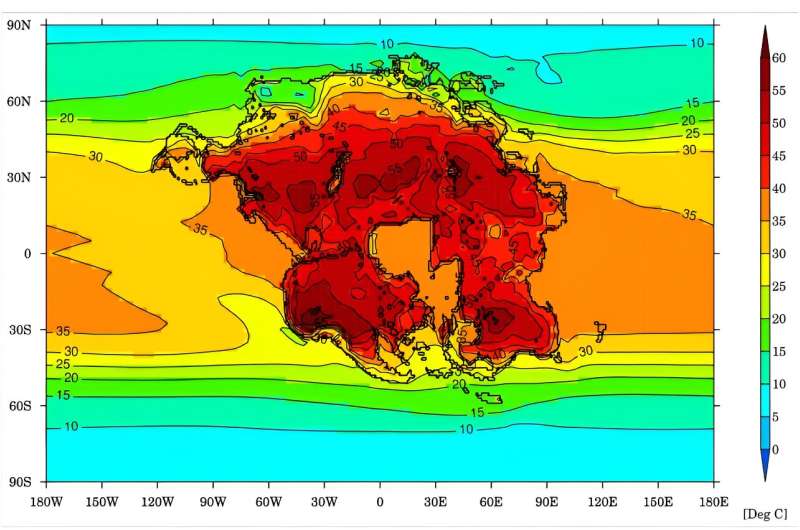This article has been reviewed according to Science X's editorial process and policies. Editors have highlighted the following attributes while ensuring the content's credibility:
fact-checked
peer-reviewed publication
trusted source
proofread
In 250 million years, a single supercontinent will form, wiping out nearly all mammals: Modeling study

A recent study published in Nature Geoscience uses supercomputer climate models to examine how a supercontinent, dubbed Pangea Ultima (also called Pangea Proxima), that will form 250 million years from now will result in extreme temperatures, making this new supercontinent uninhabitable for life, specifically mammals.
This study was conducted by an international team of researchers led by the University of Bristol and holds the potential to help scientists better understand how Earth's climate could change in the distant future from natural processes, as opposed to climate change.
The Earth's temperatures are estimated to rise drastically 250 million years from now due to two reasons: increased volcanism from the tectonic activity merging all the continents together, and our sun giving off more energy and heat as it ages. While volcanoes act as temperature moderators by releasing carbon dioxide and naturally warming the planet, too much volcanism results in too much carbon dioxide, which results in drastic temperature increases. Additionally, like mammals, our sun also grows with age, and as it grows it gives off more heat and energy.
"The newly emerged supercontinent would effectively create a triple whammy, comprising the continentality effect, hotter sun and more CO2 in the atmosphere, of increasing heat for much of the planet," said Dr. Alexander Farnsworth, who is a senior research associate at the University of Bristol and lead author of the study.
"The result is a mostly hostile environment devoid of food and water sources for mammals. Widespread temperatures of between 40 to 50 degrees Celsius, and even greater daily extremes, compounded by high levels of humidity would ultimately seal our fate. Humans—along with many other species—would expire due to their inability to shed this heat through sweat, cooling their bodies."
For the study, the researchers used computer climate models to simulate the environmental conditions of Pangea Ultima, including humidity, rain, wind, and temperature. They also determined the starting and ending CO2 levels based on biology, ocean chemistry, and tectonic processes. In the end, they found that only somewhere between 8% to 16% of Pangea Ultima's total land mass will maintain its habitability for mammals, and while human-caused climate change is estimated to increase the Earth's temperature over time, the Earth is hypothesized to remain habitable until the creation of Pangea Ultima.
The reason mammals, including humans, have survived for so long on the Earth is due to their uncanny ability to adapt to extreme weather conditions. However, while evolution has resulted in mammals being able to lower their survivable limit in cold temperatures, they aren't able to increase their survivable limit in hot temperatures. This means that as the Earth's temperatures continue to rise, it will make the likelihood of mammals surviving in these new conditions unlikely.
"The outlook in the distant future appears very bleak," said Dr. Farnsworth. "Carbon dioxide levels could be double current levels. With the sun also anticipated to emit about 2.5% more radiation and the supercontinent being located primarily in the hot, humid tropics, much of the planet could be facing temperatures of between 40°C to 70°C. This work also highlights that a world within the so-called 'habitable zone' of a solar system may not be the most hospitable for humans depending on whether the continents are dispersed, as we have today, or in one large supercontinent."
While Pangea Ultima might be dominating the Earth 250 million years from now, it won't be the first supercontinent to grace the Earth's surface in the planet's history. Scientists hypothesize there have been 10 supercontinents that have existed throughout Earth's history, with the most well-known being Pangea, the most recent supercontinent to exist. The reason all these supercontinents have existed throughout the Earth's approximately 4.5 billion-year history is due to plate tectonics since the Earth's surface is divided into seven major and eight minor plates that collide and subduct beneath each other over vast geologic periods of time.
More information: Alexander Farnsworth et al, Climate extremes likely to drive land mammal extinction during next supercontinent assembly, Nature Geoscience (2023). DOI: 10.1038/s41561-023-01259-3
Journal information: Nature Geoscience
Provided by Universe Today




















